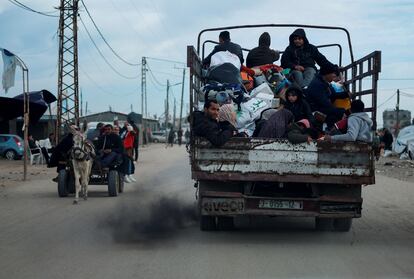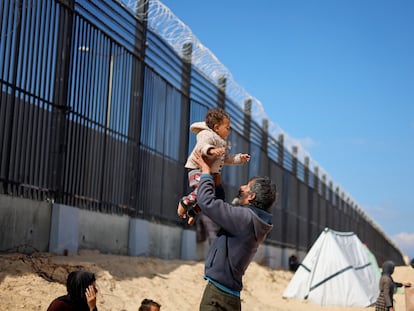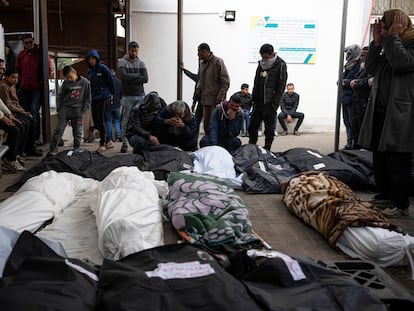Israeli and US delegations in Egypt push for a Gaza ceasefire
The goal of the negotiations with Qatar and Egypt, which have been in talks with Hamas envoys for days, is the six-week cessation of hostilities sought by U.S. President Joe Biden

The arrival of top U.S. and Israeli intelligence officials this Tuesday in Cairo has generated certain expectations about the possibility of a new ceasefire in the war ravaging Gaza. U.S. President Joe Biden announced the premise of the meeting on Monday when he said that a ceasefire of at least six weeks could be achieved, opening the door to a new exchange of Israeli hostages for Palestinian prisoners. Pressure from Israel’s main ally has trumped Prime Minister Benjamin Netanyahu’s outright refusal last week to accept the Islamists’ demands. Israel is celebrating the success of the elite uniformed forces who managed to get two hostages out of Rafah, in the southern Gaza Strip, in an operation they described as historic — and which led to dozens of Palestinian civilians being killed. However, the authorities are aware that they cannot bring all of the remaining 134 hostages home that way.
Recently, it has become “certain” that there has been “progress” in both Israel’s and Hamas’s positions, with “constructive meetings” that inspire some “optimism,” according to a foreign source on condition of anonymity, as quoted by the Israeli daily Haaretz. For days, Egyptian and Qatari negotiating teams and a Hamas delegation have been working in Cairo to pave the way for a ceasefire. The directors of Mossad (Israel’s foreign intelligence service), David Barnea, and the U.S. Central Intelligence Agency (CIA), William Burns, have now joined them.
In a public statement, the families of the hostages implored the Israeli negotiators in Cairo to “not come back until everyone returns home, [both] the living and the dead.” According to the authorities, 31 of the 134 captives are already dead. “The eyes of 134 hostages are on you. This is a once-in-a-lifetime mission, and you have the ability to rescue 134 captives and prevent them from meeting the same fate as Ron Arad,” they added, referring to an Israeli serviceman who has been missing for almost four decades.
That month-and-a-half cessation of hostilities, to which Biden referred after a meeting with King Abdullah II of Jordan, would be six times longer than the war’s first ceasefire, which only lasted for one week at the end of November. Neither the negotiators nor the parties to the conflict have revealed details from the negotiations, such as the number of Palestinian prisoners to be released for each hostage or the profile of the prisoners to be released from Israeli jails. In any case, the United States believes that, if achieved, those six weeks would serve as a springboard for accomplishing more ambitious objectives that could possibly lead to ending the conflict in which almost 28,500 have been killed in Gaza since October 7.
According to local media, in recent hours, the momentum with which Israel announced that it was going to enter Rafah with its troops, guns blazing, has also been deflating. The presence of over a million displaced people who have nowhere to go, combined with the lack of an agreement with Egypt — which shares a border with the southern Gaza town — complicate these plans. In addition, the United Nations noted today that it does not intend to participate in any operation to forcibly move the population in Rafah, which Israel would rely on in order to carry out the operation against the Hamas battalions that, Israel claims, are in the area.
“We have not received any formal communication from Israeli officials,” Jens Laerke, spokesman for the U.N. Office for Humanitarian Affairs, told Reuters. “In any case, the U.N. is not involved in forced and non-voluntary evacuations. There are no plans at this time to facilitate the evacuation of civilians,” he added.
The U.S. has insisted that the ground invasion of Rafah cannot be carried out without a feasible plan for evacuating the hundreds of thousands of civilians. Thus far, no one on the Israeli side has explained how they can put that into practice. Over half of Gaza’s 2.3 million inhabitants are crowded in and around Rafah. The vast majority lack shelter, food, water and basic supplies for survival.
Although Israel has not launched its ground incursion into Gaza’s southernmost tip, the country’s troops continue to pound Rafah on a daily basis. On Tuesday, a drone strike seriously injured an editor and a cameraman for the Qatar-based Al Jazeera network, which reported that this is the fifth time Israel has carried out such actions against its reporters during the current conflict. A cameraman was killed in December.
Centrist minister Benny Gantz outlines the government’s plan, which envisages negotiations, continuing with the military steamroller and freeing the hostages all at once. “We will hold talks with our friends around the world” and “take the steps that will give us freedom of action: evacuate the population, secure the borders and perform the necessary preparatory work for a ground invasion, and we will act,” Gantz was quoted as saying in the Israeli daily Maariv.
Despite Israeli Prime Minister Benjamin Netanyahu’s blunt refusal last week to accept the demands of the Palestinian Islamists, faced with the need to bring the hostages home, he was open to continuing negotiations. The go-ahead for the Barnea-led delegation’s trip is seen as a step toward a possible ceasefire. Since the war began on October 7, the guns only fell silent during the last week of November. At that time, in different exchanges, 105 hostages were allowed to leave Gaza and 240 Palestinian prisoners, women and minors, were released from Israeli jails. There are still 134 hostages in the Gaza Strip; according to Israel, 31 of them are already dead.
Sign up for our weekly newsletter to get more English-language news coverage from EL PAÍS USA Edition
Tu suscripción se está usando en otro dispositivo
¿Quieres añadir otro usuario a tu suscripción?
Si continúas leyendo en este dispositivo, no se podrá leer en el otro.
FlechaTu suscripción se está usando en otro dispositivo y solo puedes acceder a EL PAÍS desde un dispositivo a la vez.
Si quieres compartir tu cuenta, cambia tu suscripción a la modalidad Premium, así podrás añadir otro usuario. Cada uno accederá con su propia cuenta de email, lo que os permitirá personalizar vuestra experiencia en EL PAÍS.
¿Tienes una suscripción de empresa? Accede aquí para contratar más cuentas.
En el caso de no saber quién está usando tu cuenta, te recomendamos cambiar tu contraseña aquí.
Si decides continuar compartiendo tu cuenta, este mensaje se mostrará en tu dispositivo y en el de la otra persona que está usando tu cuenta de forma indefinida, afectando a tu experiencia de lectura. Puedes consultar aquí los términos y condiciones de la suscripción digital.
More information
Archived In
Últimas noticias
Most viewed
- Sinaloa Cartel war is taking its toll on Los Chapitos
- Oona Chaplin: ‘I told James Cameron that I was living in a treehouse and starting a permaculture project with a friend’
- Reinhard Genzel, Nobel laureate in physics: ‘One-minute videos will never give you the truth’
- Why the price of coffee has skyrocketed: from Brazilian plantations to specialty coffee houses
- Silver prices are going crazy: This is what’s fueling the rally











































